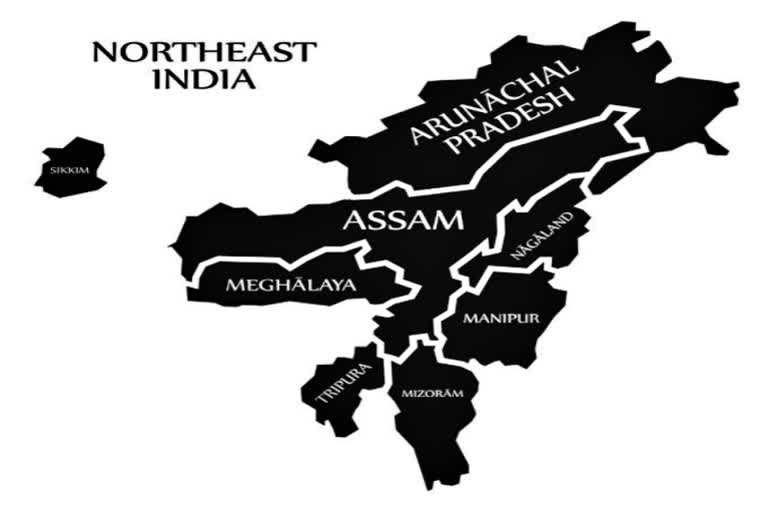New Delhi: Very soon, Indian youth need not go to Japan to learn Japanese, they will be able to do so in Guwahati or Kohima even as the cherry blossoms in Shillong’s Wards Lake and Polo Ground mirror the dreamy beauty of Japan’s famous cherry blossoms. While these are just a few among the slew of initiatives that would bring India and Japan closer, the strategic ties with profound intent will hover close by…
Of the many converging grounds deliberated during the interaction of PM Narendra Modi with his Japanese counterpart Kishida Fumio during the latter’s official visit to New Delhi from March 19-20, 2022, for the 14th India-Japan Annual Summit, an area where the interests find a huge sweep of common ground is India’s Northeast region (NER) comprising eight states of Arunachal Pradesh, Assam, Manipur, Meghalaya, Mizoram, Nagaland, Sikkim and Tripura.
Besides a wide array of joint projects to spur development, the NER geography is crucial from the strategic point located as it is amid China, Myanmar, Bangladesh, Bhutan and Nepal, and connected by only a thin land corridor to the Indian mainland. Encouraged by early success, the two countries have just set a new investment target of five trillion yen (Rs 3,20,000 crore) in the next five years. In a possible reference to China’s belligerence at the Indian borders and the ongoing Russian-Ukraine conflict, PM Modi said geo-political events are presenting new challenges.
“This visit of Prime Minister Kishida has been successful in adding new dimensions to the India-Japan special strategic and global partnership,” he added. The relationship is indicative of a strategic collaboration between the two countries based on a shared commitment of all-round development with focus on infrastructure, renewable energy and people to people connect which will seek to use New Delhi’s flagship ‘Act East Policy’ (AEP) as a lever to ensure the free, open and inclusive Indo-Pacific (FOIP) vision.
India’s AEP seeks to leverage NER’s close cultural and ethnic ties as a bridge to connect with the South-East Asian nations. On the other hand, Japan is keen to invest in the region and has already set up a body called ‘India-Japan Coordination Forum for Development of Northeast’ in 2017 to build infrastructure in the region. Six meetings of the body have already taken place.
Moreover, with the insurgencies of Assam, Manipur and Nagaland on the wane, the road to Indo-China and the Far East is already marked by much tranquility and peace than ever before. The corollary is that the NER would become a vital geography in the effort to oppose China’s growing influence and sway in the Indo-China region.
A release from India’s foreign ministry on Saturday said: “India and Japan have decided to launch a comprehensive initiative for sustainable development of NER. This will complement existing developmental initiatives of the state governments of NER and the government of India… The scope of activities under the Initiative will be covered under the umbrella of AEF and will build on the inherent strengths of NER.”
The ongoing India-Japan projects and those with potential for future cooperation cover the following areas: Capacity enhancement for sustainable agriculture and irrigation development in Mizoram, development of agro-industries in NER especially through SMEs with special focus on bamboo, food processing, tea industry, organic farming and horticulture, art and cultural exchanges between NER and Japan, including Shillong Cherry Blossom Festival in Meghalaya, promoting Japanese language education, water supply and sewerage projects in Guwahati, sustainable urban development in the Kohima Smart City Mission, healthcare, improving road connectivity, promoting sustainable forest use, etc.
Speaking at an event in Guwahati on February 15, 2021, Suzuki Satoshi, Japan’s ambassador to India, had aptly summed it: “Northeast is situated where India’s Act East Policy and Japan’s vision for a free and open Indo-Pacific converge. To be “free and open” is critical…” India and Japan are already part of the ‘Quadrilateral Security Dialogue’ or ‘Quad’, a grouping broadly understood to be a anti-China platform, besides the ‘2 plus 2’ where the defence and foreign ministers of both the countries meet.
In their joint statement on Saturday, the two PMs reaffirming the Special Strategic and Global Partnership between India and Japan also acknowledged the ongoing collaboration in the area of Unmanned Ground Vehicle (UGV) and Robotics. The PMs directed their ministers to further identify concrete areas for future cooperation in the area of defence equipment and technology.
Also read: Japan to invest USD 42 billion in India over next five years




